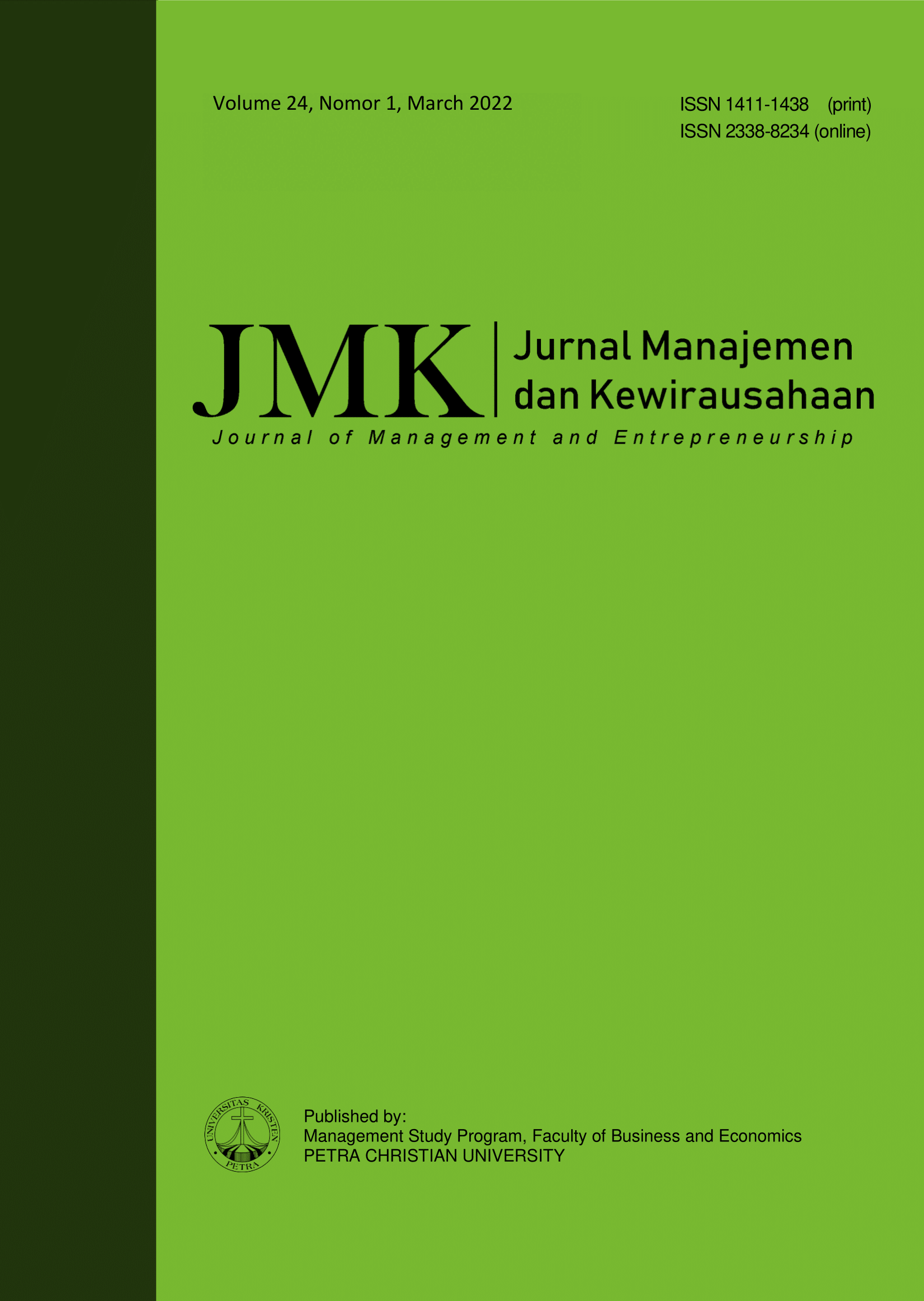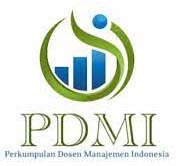HERD INSTINCT BIAS, EMOTIONAL BIASES, AND INFORMATION PROCESSING BIASES IN INVESTMENT DECISIONS
 :
:
https://doi.org/10.9744/jmk.24.2.105-117
Keywords:
Herding bias, overconfidence, endowment bias, recency bias, confirmation bias, investment decision.Abstract
The evolution of information during the COVID-19 pandemic has altered how investors invest. Investments can be made easily on a variety of digital platforms that provide easy access to information in investment decisions. Information media is expanding to promote investment decision making, boosting the rise and development of investor financial behavior bias. This study attempts to fill a knowledge gap in behavioral finance by concentrating on behavioral biases such as Herd Instinct Bias, Emotional Biases, and Information Processing Biases in capital market investment decisions. PLS-SEM (Partial Least Square-Structural Equation Modeling) was used to evaluate the data of 205 Indonesian capital market investors who are members of securities companies. The data confirm that overconfidence, herding bias, confirmation bias, and recency bias influence investor investment decisions, whereas endowment bias had no effect on investment decisions.
References
Ackert, L., & Deaves, R. (2010). Behavioral finance: Psychology, decision-making, and markets. Cengage Learning: South-Western, USA.
Ahlawat, S. S. (1999). Order effects and memory for evidence in individual versus group decision making in auditing. Journal of Behavioral Decision Making, 12 (1), 71–88.
Akhtar, F., & Das, N. (2019). Predictors of investment intention in Indian stock mar¬kets: Extending the theory of planned behaviour. International Journal of Bank Marketing. 37(1), 97–119. https://doi.org/10.1108/IJBM-08-2017-0167
Allam, S., Abdelrhim, M., & Mohamed, M. (2020). Determinants of herding behavior in the time of COVID-19: The case of Egyptian stock market sectors. SSRN Electronic Journal, 1–35. https://doi.org/10.2139/ssrn.3717995
Almilia, L. S., Hartono, J., Supriyadi, & Na¬har¬tyo, E. (2013). Examining the effects of presentation patterns, orders, and information types in investment decision making. Gadjah Mada International Journal of Business, 15(2), 171–182. https://doi.org/10.22146/gamaijb.5701
Anwar, M., Khan, S. Z., & Rehman, A. U. (2017). Financial literacy, behavioral biases and investor’s portfolio diversi¬fica¬tion: Empirical study of an emerging stock market. Journal of Finance & Economics Research, 2(2), 145–164. https://doi.org/10.20547/jfer1702204
Armansyah, R. F. (2018). Herd behavior and Indonesian financial crisis. Journal of Advanced Management Science, 6(2), 86–89. https://doi.org/10.18178/joams.6.2. 86-89
Armansyah, R. F. (2020). A study of investor financial behavior on online trading system in Indonesian stock exchange: E-sa¬tis¬faction, e-loyalty, and e-trust. Journal of Economics, Business, & Accoun-tancy Ventura, 23 (1), 69–84. https://doi.org/10 .14414/jebav.v23i1.2176
Armansyah, R. F. (2021). Over confidence, mental accounting, and loss aversion in investment Decision. Journal of Auditing, Finance, and Forensic Accounting, 9(1), 44–53. https://doi. org/10.21107/jaff a.v9i1.10523
Baihaqqy, M. R. I., Disman, Nugraha, Sari, M., & Ikhsan, S. (2020). The effect of fi¬nan¬cial literacy on the investment decision. Budapest International Research and Critics Institute (BIRCI-Journal): Humanities and Social Sciences, 3(4), 3073–3083. https://doi.org/10.33258/birci.v3i4.1333
Chen, G., Kim, K. A., Nofsinger, J. R., & Rui, O. M. (2007). Trading performance, disposition effect, overconfidence, representativeness bias, and experience of emerging market investors. Journal of Behavioral Decision Making, 20 (4), 425–451. https://doi.org/10.1002/bdm.561
Cheng, C. X. (2019). Confirmation bias in investments. International Journal of Economics and Finance, 11(2), 50–55. https://doi.org/10.5539/ijef.v11n2p50
Chinn, W. W. (1998). The partial least squares approach to structural equation modelling. In G. A. Mercoulides (Ed.), Modern methods for business research (pp. 295–336). Lawrence Elbaum Associates.
Combrink, S., & Lew, C. (2020). Potential underdog bias, overconfidence and risk propensity in investor decisionmaking behavior. Journal of Behavioral Finance, 21(4). https://doi.org/10.1080/15427560.2019.1692843
Durand, R. B., Patterson, F. M., & Shank, C. A. (2021). Behavioral biases in the NFL gambling market: Overreaction to news and the recency bias. Journal of Behavioral and Experimental Finance, 31. https://doi.org/10.1016/j.jbef.2021.100522
Ericson, K. M., & Fuster, A. (2014). The endowment effect. Annual Review of Economics, 6(1), 555–579. https://doi.org/10.1146/annurev-economics-080213-041320
Espinosa-Méndez, C., & Arias, J. (2021). COVID-19 effect on herding behaviour in European capital markets. Finance Research Letters, 38. https://doi.org/10.1016/j.frl.2020.101787
Fachrudin, K. R., Lumbanraja, P., Sadalia, I., & Lubis, A. N. (2017). Analysis of heuristic behavior on investment decision. International Journal of Economic Research, 14(20), 297–309.
Faruq, N. A. (2021). Schroders Indonesia: Minat investasi terus meningkat di tengah pandemi. Retrieved from https://investor. id/market-and-corporate/261786/schroders-indonesia-minat-investasi-terus-menin gkat-di-tengah-pandemi
Gavrilakis, N., & Floros, C. (2022). The impact of heuristic and herding biases on portfolio construction and performance: The case of Greece. Review of Behavioral Finance, 14(3), 436–462. https://doi.org/10.1108/RBF-11-2020-0295
Ghozali, I. (2014). Structural equation modeling, metode alternatif dengan partial least square (PLS). Badan Penerbit Universitas Diponegoro.
Hair Jr., J. F., Matthews, L. M., Matthews, R. L., & Sarstedt, M. (2017). PLS-SEM or CB-SEM: Updated guidelines on which method to use. International Journal of Multivariate Data Analysis, 1(2), 107–123. https://doi.org/10.1504/ijmda.2017.10008574
Hribar, P., & Yang, H. (2016). CEO Overconfidence and management forecasting. Concounting Research, 33 (1), 204–227. https://doi. org/10.1111/19 11-3846.12144
Hwang, H., & Takane, Y. (2004). Generalized structured component analysis. Psychometrika, 69(1), 81–99. https://doi.org/10.1007/BF02295841
Kansal, P., & Singh, S. (2018). Determinants of over-confidence bias in Indian stock market. Qualita-tive Research in Financial Markets, 10(4), 381–394. https://doi.org/10.1108/QRFM-03-2017-0015
Khan, A. R., Azeem, M., & Sarwar, S. (2017). Impact of overconfidence and loss aversion biases on investment decision: Moderating role of risk perception. International Journal of Transfor-mation in Accounting, Auditing & Taxation, 1(1), 23–35.
Konstantinidis, A. D., Katarachia, A., & Sis¬kou, T. (2019). Disposition effect, endowment effect, attachment bias and investment advisers. IOSR Journal of Business and Management, 21(2), 16–21.
KSEI (Indonesia Central Securities Depository). (2022). Statistik pasar modal Indonesia Mei 2022. Retrieved from https://www.ksei.co.id/publications/demografi_investor
Kurniawan, B., & Murhadi, W. R. (2018). Bias aspect in decision making for buying life insurance in Indonesia. A paper presented in 2nd International Seminar of Contemporary Research on Business and Management, 30–31 Juli 2018, Universitas Warmadewa, Denpasar, Bali.
Malik, M. S., Hanif, M. I., & Azhar, M. Z. (2019). The impact of overconfidence bias on investment decisions: Mediating role of risk tolerance. International Journal of Research and Innovation in Scoial Science, 3(8), 154–160.
Monecke, A., & Leisch, F. (2012). SemPLS: Structural equation modeling using partial least squares. Journal of Statistical Software, 48(3), 1–32. https://doi.org/10.18637/jss.v048.i03
Mushinada, V. N. C., & Veluri, V. S. S. (2020). Selfattribution, overconfidence and dynamic market volatility in Indian stock market. Global Business Review, 21(4), 970–989. https://doi.org/10.1177/097215 0918779288
Ngoc, L. T. B. (2014). Behavior pattern of individual investors in stock market. International Journal of Business and Management, 9(1), 1–16. https://doi.org/10.55 39/ijbm.v9n1p1
Nofsinger, J. R. (2016). The psychology of investing. 5th Edition.New York, NY: Routledge https://doi.org/10.4324/9781315506579
Novianggie, V., & Asandimitra, N. (2019). The influence of behavioral bias, cognitive bias, and emotional bias on investment decision for college students with financial literacy as the moderating variable. International Journal of Academic Research in Accounting, Finance and Management Sciences, 9(2), 92–107. http://dx.doi.org/10.6007/IJARAFMS/v9i2/6044%0Ahttp://creativecommons.org/licences/by/4.0/legalcode
Özen, E., & Ersoy, G. (2019). The impact of financial literacy on cognitive biases of individual inves-tors. In S. Grima, E. Özen, H. Boz, J. Spiteri, & E. Thalassinos (Eds.), Contemporary issues in behavioral finance (contemporary studies in economic and financial analysis, volume 101) (pp. 77–95). Emerald Publishing Limited, Bingley. https://doi. org/10.1108/S1569-375920190000101007
Park, J. H., Konana, P., Gu, B., Kumar, A., & Raghunathan, R. (2012). Confirmation bias, overcon-fidence, and investment performance: Evidence from stock message boards. McCombs Research Paper Series No. IROM-07-10. https://doi.org/10.213 9/ssrn.1639470
Patel, A. (2005). Auditors’ belief revision: Recency effects of contrary and supporting audit evidence and source reliability. USP Dept. of AFM/SSED Working Paper No. 2001-1. https://doi.org/10. 2139/ssrn. 277393
Peñón, I. E., & Ortega, S. R. (2018). The endowment effect on entrepreneurs: A risky attachment. Estu-dios de Economia, 45(2), 231–249. https://doi.org/10.4067/S0718-52862018000200231
Pinsker, R. (2011). Primacy or recency? A study of order effects when nonprofessional investors are provided a long series of disclosures. Behavioral Research in Accounting, 23(1), 161–183. https://doi.org/10.2308/bria.2011.23.1.161
Pompian, M. M. (2012). Behavioral finance and wealth management: How to build investment strategies that account for in-vestor biases. https://doi.org/10.1002/9781119202400
Pradita, V., & Wiwik, L. (2019). Study of demographic factors and financial literation and its effect on individual investment decision in generation x and generation y. The International Conference of Business and Banking Innovations (ICOBBI) 2019 Proceedings. https://doi.org/ 10.6084/m9.figshare.9849122
Putri, P. T., & Simanjuntak, M. (2020). The role of motivation, locus of control and financial literacy on women investment decisions across genera-tions. Journal of Consumer Sciences, 5(2), 102–123. https: //doi.org/10.29244/jcs.5.2.102-123
Qasim, M., Hussain, R. Y., Mehboob, I., & Arshad, M. (2019). Impact of herding behavior and over-confidence bias on investors’ decision-making in Pakistan. Accounting, 5(2), 81–90. https://doi.org/10.52 67/j.ac.2018.7.001
Rabbani, A. G., Grable, J. E., O’Neill, B., Lawrence, F., & Yao, Z. (2021). Financial risk tolerance before and after a stock market shock: Testing the recency bias hypothesis. Journal of Financial Counseling and Planning, 32(2), 294–310. https://doi.org/10.1891/JFCP-19-00025
Rahman, M., & Gan, S. S. (2020). Generation y invest-ment decision: An analysis using behavioural factors. Managerial Finance, 46(8), 1023–1041. https://doi.org/10.110 8/MF-10-2018-0534
Ricciardi, V., & Simon, H. (2000). What is behavioral finance? Business, Education, and Technology Journal, Fall: 1–9.
Rudiawarni, F. A., Narsa, I. M., & Tjahjadi, B. (2020). Are emotions exacerbating the recency bias?: An experimental study. International Journal of Trade and Global Markets, 13(1), 61–70. https://doi.org/10.1504/IJTGM.2020.104913
Selden, G. C. (1912). Psychology of the stock market. New York, NY: Ticker Publishing Company.
Shefrin, H. (2007). Behavioral corporate finance. Journal of Applied Corporate Finance, 14(3), 113–124. https://doi.org/10.11/j.17456622.2001.tb00443.x
Statman, M. (2008). What is behavioral finance? In F. J. Fabozzi (Ed.), Handbook of Finance. https://doi.org/10.1002/9780470404324.hof002009
Subash, R. (2012). Role of behavioral finance in portfolio investment decisions: Evidence from India. Thesis. Faculty of Social Science, Institute of Economic Studies, Charles University in Prague.
Sukamulja, S., Meilita, A. Y. N., & Senoputri, D. (2019). Regret aversion bias, mental accounting, overconfidence, and risk perception in investment decision making on generation y workers in Yogyakarta. International Journal of Economics and Management Studies, 6(7), 102–110. https://doi.org/10.14445/23939125/ijems-v6i7p116
Tjandrasa, B. B., & Tjandraningtyas, J. M. (2018). The Effects of personality types and demographic factors on overconfidence bias and decision making of investment types. Petra International Journal of Business Studies, 1(2), 57–62. https://doi.org/10.9744/ijbs.1.2.57-62
Trehan, B., & Sinha, A. K. (2021). A study of confirmation bias among online investors in virtual communities. International Journal of Electronic Finance, 10(3), 159–179. https://doi.org/10.1504/IJEF.2021.1 15647
Weber, M., Weber, E. U., & Nosić, A. (2013). Who takes risks when and why: Determinants of changes in investor risk taking. Review of Finance, 17(3), 847–883. https://doi.org/10.1093/rof/rfs024
Zaleskiewicz, T. (2015). Behavioral finance. In M. Altman (Ed.), Handbook of contemporary beha-vioral economics: Foundations and developments. Routledge. https: //doi.org/10.4324/97813 15703879-52
Downloads
Published
How to Cite
Issue
Section
License
Authors who publish on this journal agree to the following terms:
- Authors retain copyright and grant the journal right of first publication with the work simultaneously licensed under a Creative Commons Attribution License that allows others to share the work with an acknowledgement of the work's authorship and initial publication in this journal.
- Authors are able to enter into separate, additional contractual arrangements for the non-exclusive distribution of the journal's published version of the work (e.g., post it to an institutional repository or publish it in a book), with an acknowledgement of its initial publication in this journal.
- Authors are permitted and encouraged to post their work online (e.g., in institutional repositories or on their website) prior to and during the submission process, as it can lead to productive exchanges, as well as earlier and greater citation of published work (See The Effect of Open Access).


















